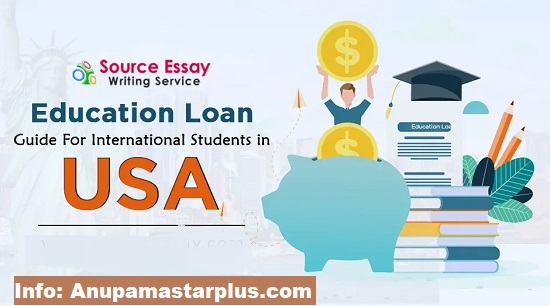International Study Loan
Embarking on a journey of higher education abroad opens doors to endless opportunities for personal and professional growth. However, the financial aspect can often be a hurdle for many aspiring students. This comprehensive guide delves into the realm of Study Loan in USA, offering insights, tips, and invaluable information to help you navigate the process with confidence and ease.
Understanding the Basics
Embarking on a journey of higher education abroad opens doors to endless opportunities for personal and professional growth. However, the financial aspect can often be a hurdle for many aspiring students. This comprehensive guide delves into the realm of Study Loan in USA, offering insights, tips, and invaluable information to help you navigate the process with confidence and ease.
What is a Study Loan?
A study loan, also known as an education loan, is a financial aid provided to students to cover expenses related to their education, including tuition fees, living expenses, books, and other educational necessities.
Why Choose an international Loan?
International study loans are specifically tailored for students pursuing education abroad. These loans offer flexible repayment options and competitive interest rates, making them an attractive choice for aspiring international students.

Benefits of Study Loan in USA
- Financial Support: Study loans provide the necessary funds to cover tuition fees, living expenses, and other educational costs, easing the financial burden on students and their families.
- Flexibility: International study loans offer flexible repayment terms, allowing students to focus on their studies without worrying about immediate repayment obligations.
- Build Credit History: Timely repayment of study loans helps students build a positive credit history, which can be beneficial for future financial endeavors.
- Global Exposure: Studying abroad opens doors to diverse cultures, perspectives, and experiences, enriching students’ personal and academic growth.
Navigating the Application Process
Securing a study loan for international education involves several steps and considerations. Here’s a step-by-step guide to help you navigate the application process seamlessly:
Research and Compare Loan Options
Before applying for a study loan, conduct thorough research to explore different lenders, loan terms, interest rates, and eligibility criteria. Compare various options to find the best fit for your financial needs and academic aspirations.
Gather the required documents.
Prepare all necessary documents, including academic transcripts, standardized test scores, proof of admission, financial statements, and identification documents. Having these documents ready will streamline the application process and expedite loan approval.
Calculate the loan amount
Determine the total cost of your education, including tuition fees, accommodation, living expenses, travel costs, and other miscellaneous expenses. Calculate the amount you need to borrow to cover these expenses while ensuring affordability and sustainability.
Complete the Application Form
Fill out the study loan application form accurately and thoroughly, providing all required information and supporting documents. Pay close attention to the instructions and deadlines to avoid delays or complications in the processing of your application.
Review Terms and Conditions
Carefully review the terms and conditions of the loan agreement, including interest rates, repayment options, grace periods, and penalties for late payments. Seek clarification on any clauses or terms that are unclear or confusing before signing the agreement.
Submit Application and Await Approval
Once you’ve completed the application form and gathered all necessary documents, submit your application to the chosen lender. Await approval and follow up promptly if any additional information or documentation is required.
Securing Financial Assistance
Securing a study loan for international education involves several steps and considerations. Here’s a step-by-step guide to help you navigate the application process seamlessly:
Eligibility Criteria
- Academic Excellence: Many lenders require applicants to demonstrate academic excellence through high grades or standardized test scores.
- Admission to Accredited Institution: Applicants must provide proof of admission to an accredited educational institution or program.
- Financial Stability: Lenders may assess applicants’ financial stability and creditworthiness to determine their eligibility for a study loan.
Interest Rates and Repayment Terms
- Fixed vs. Variable Interest Rates: Study loans may offer fixed or variable interest rates. Fixed rates remain constant throughout the loan term, providing stability and predictability in repayment. Variable rates fluctuate based on market conditions, offering the potential for savings or increased costs.
- Repayment Options: Study loans typically offer flexible repayment options, including deferred repayment, interest-only payments, and standard repayment plans. Choose a repayment plan that aligns with your financial situation and long-term goals.
Financial Planning and Budgeting
- Create a detailed budget outlining your anticipated expenses, including tuition fees, accommodation, living expenses, textbooks, transportation, and personal expenses.
- Explore scholarship opportunities, grants, part-time employment, and other sources of funding to supplement your study loan and reduce the overall financial burden.
Understanding Loan Terms and Conditions
- Read the fine print of the loan agreement carefully, paying attention to interest rates, repayment terms, grace periods, late payment fees, and other relevant provisions.
- Seek clarification on any terms or clauses that are unclear or ambiguous to ensure you fully understand your rights and obligations as a borrower.

FAQs (Frequently Asked Questions)
- Can international students apply for study loans in the USA?
- Yes, many lenders in the USA offer study loans specifically designed for international students pursuing higher education in the country. These loans typically require a co-signer who is a US citizen or permanent resident.
- What documents are required for a study loan application?
- Required documents may vary depending on the lender, but commonly requested documents include academic transcripts, standardized test scores, proof of admission, financial statements, identification documents, and a co-signer’s information (if applicable).
- How do study loan interest rates affect repayment?
- Interest rates play a crucial role in determining the total cost of your study loan and the amount you’ll repay over time. Higher interest rates result in higher monthly payments and overall repayment amounts, while lower rates translate to lower costs for borrowers.
- Can study loans be used to cover living expenses?
- Yes, study loans can be used to cover various expenses related to education, including tuition fees, accommodation, living expenses, textbooks, transportation, and personal expenses. However, borrowers should borrow responsibly and budget wisely to ensure they can comfortably repay the loan upon graduation.
- What are the consequences of defaulting on a study loan?
- Defaulting on a study loan can have serious consequences, including damage to your credit score, legal action by the lender, wage garnishment, and seizure of tax refunds. It’s crucial to communicate with your lender if you’re facing financial difficulties and explore options for alternative repayment plans or loan forgiveness programs.
- Are there any scholarship opportunities available for international students in the USA?
- Yes, there are numerous scholarship opportunities available for international students in the USA, offered by universities, government organizations, non-profit foundations, and private institutions. These scholarships can help offset the cost of tuition and living expenses, reducing the need for excessive borrowing.



